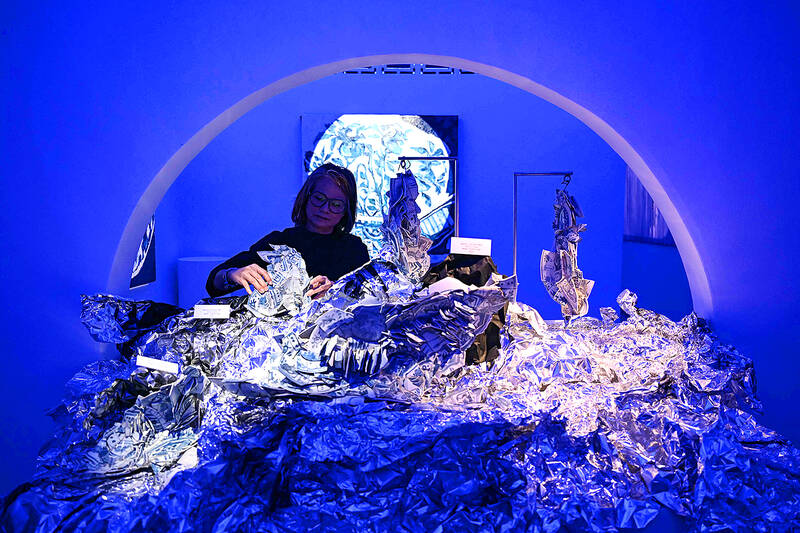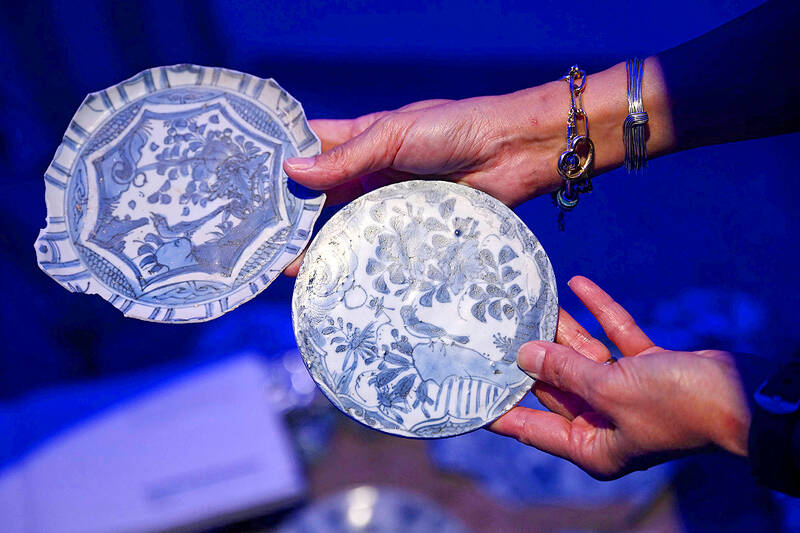Chinese porcelain shards salvaged from a famous shipwreck are being reimagined in Malaysia, hundreds of years after the Portuguese vessel is said to have sunk in battle.
The smashed 17th-century crockery was almost consigned to the scrap heap before Malaysian artist Alice Chang saw the potential to transform the shattered plates and cups. After chancing upon a social media post selling the porcelain fragments, the 57-year-old bought about 50kg for more than 10,000 ringgit (US$2,370). Her recent solo exhibition “Me, Then Blue” at her studio in Ampang, a suburb of the capital Kuala Lumpur, turned the porcelain into sculptures representing submerged dreamscapes.
Her materials are fragments of a once-great cargo of blue-and-white pottery made in Jingdezhen, China’s renowned porcelain capital. The cargo was carried by a Portuguese merchant vessel that sank around 1625, likely due to a battle off Malaysia’s coast. It was discovered in 1998 after pottery appeared in fishermen’s nets, with the vessel then named the Wanli after the Ming Dynasty emperor who ruled when the ship sank.

Photo: AFP
It was hailed as one of the most significant maritime finds in Southeast Asia and is now recognized under UNESCO’s Silk Roads Programme. But while intact porcelain pieces were preserved in museums, Chang said the broken shards were “cast aside as useless.”
“The 400 years of broken porcelain tell a story of our past and a look into our future. If nobody wanted them, they would be thrown away, and that is such a waste,” Chang said.
She used the shards to create the “ambience of this exhibition like it’s immersed in the deep blue sea,” Chang said. “This is part of Malaysia’s history... its maritime legacy often goes unrecognized, and this discovery felt like a forgotten chapter waiting to be told,” she said.

Photo: AFP
‘BEAUTY IN BROKENNESS’
At the heart of Chang’s exhibition stood 11 sculptures, adorned with salvaged shards, accompanied by 20 oil paintings.
Working with the broken porcelain pieces was “deeply personal” for Chang, a second-generation Malaysian with Chinese roots who often felt culturally unmoored.
“Through the Wanli shipwreck and working with the pieces, I feel reconnected... I have been told I’m not very Chinese because I’m married to an Italian. So I’m neither here nor there,” she chuckled. “This project reconnected me to my Chinese roots. I actually travelled to China to search and understand my culture.”
Some of her sculptures evoked ornate vases while others resembled cascading waves, with mirrors beneath them mimicking the glimmering seabed.
They show “the beauty in brokenness,” Chang said.
“Depending on your perspective, you can turn brokenness into something beautiful.”

Oct. 27 to Nov. 2 Over a breakfast of soymilk and fried dough costing less than NT$400, seven officials and engineers agreed on a NT$400 million plan — unaware that it would mark the beginning of Taiwan’s semiconductor empire. It was a cold February morning in 1974. Gathered at the unassuming shop were Economics minister Sun Yun-hsuan (孫運璿), director-general of Transportation and Communications Kao Yu-shu (高玉樹), Industrial Technology Research Institute (ITRI) president Wang Chao-chen (王兆振), Telecommunications Laboratories director Kang Pao-huang (康寶煌), Executive Yuan secretary-general Fei Hua (費驊), director-general of Telecommunications Fang Hsien-chi (方賢齊) and Radio Corporation of America (RCA) Laboratories director Pan
The consensus on the Chinese Nationalist Party (KMT) chair race is that Cheng Li-wun (鄭麗文) ran a populist, ideological back-to-basics campaign and soundly defeated former Taipei mayor Hau Lung-bin (郝龍斌), the candidate backed by the big institutional players. Cheng tapped into a wave of popular enthusiasm within the KMT, while the institutional players’ get-out-the-vote abilities fell flat, suggesting their power has weakened significantly. Yet, a closer look at the race paints a more complicated picture, raising questions about some analysts’ conclusions, including my own. TURNOUT Here is a surprising statistic: Turnout was 130,678, or 39.46 percent of the 331,145 eligible party

The classic warmth of a good old-fashioned izakaya beckons you in, all cozy nooks and dark wood finishes, as tables order a third round and waiters sling tapas-sized bites and assorted — sometimes unidentifiable — skewered meats. But there’s a romantic hush about this Ximending (西門町) hotspot, with cocktails savored, plating elegant and never rushed and daters and diners lit by candlelight and chandelier. Each chair is mismatched and the assorted tables appear to be the fanciest picks from a nearby flea market. A naked sewing mannequin stands in a dimly lit corner, adorned with antique mirrors and draped foliage

The election of Cheng Li-wun (鄭麗文) as chair of the Chinese Nationalist Party (KMT) marked a triumphant return of pride in the “Chinese” in the party name. Cheng wants Taiwanese to be proud to call themselves Chinese again. The unambiguous winner was a return to the KMT ideology that formed in the early 2000s under then chairman Lien Chan (連戰) and president Ma Ying-jeou (馬英九) put into practice as far as he could, until ultimately thwarted by hundreds of thousands of protestors thronging the streets in what became known as the Sunflower movement in 2014. Cheng is an unambiguous Chinese ethnonationalist,